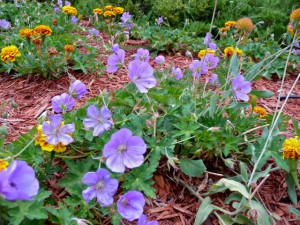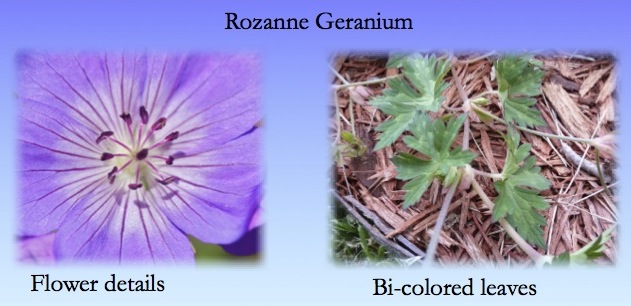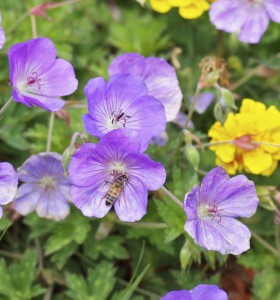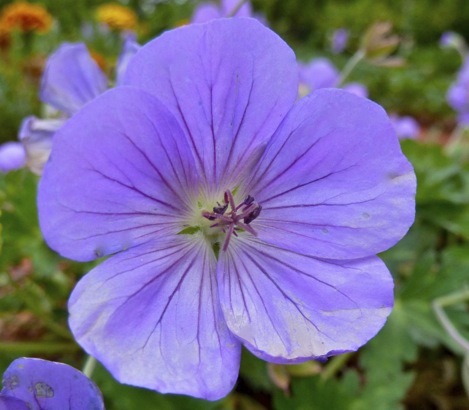Scientific name: Geranium ‘Gerwat’ Rozanne
Common name: Rozanne geranium
Plant Family: Geraniaceae (Geranium)
Article and photos by Janice Tucker
The Rozanne geranium produces multitudes of violet-blue flowers that will bloom from early summer until frost, has beautiful leaves that also offer brilliant fall color, spreads but does not invade and as an added bonus it grows very well in the Santa Fe environment. The Rozanne geranium is one of the plants chosen for the and is growing in the orchard border at the newly opened Santa Fe Botanical Garden at Museum Hill, 715 Camino Lejo. Treat yourself to a visit soon.
The Rozanne is a perennial with compact clumps that grow 18 to 20 inches in height and spread to 2 feet wide in most locations. The marbled, dark green and yellow leaves are deeply divided into 5 distinct lobes. As summer gives over to the cooler temperatures of autumn, the leaves turn a rich shade of red. The 2 to 2 ½ inch flowers are a study in gradient colors. The tips of the petals are a dark violet-blue hue that blends into a paler shade, eventually merging with a white center. There are distinctive purple veins radiating from the center upward through each petal. Dark, velvety, reddish-purple anthers rise like a fountain from the flower’s center. The Rozanne is a cultivar from species of the Geranium genus and is sometimes commonly called a “Cranesbill” geranium, which refers to the shape of its seedpod.
The Rozanne should be located in a sunny or partially sunny area, making certain that it receives a minimum of 3 hours of sun daily. Plant it in well-drained soil after fear of frost in spring or before frost in the fall. After the plant is established, water moderately. Prune it back in late summer to keep the shape compact and to encourage more blooms. The Rozanne can be divided in spring or fall. It will turn heads when planted en masse and gives flowerbeds and walkways a certain panache when used as a border. Even though it spreads, it will live amicably with other plants. Its low, spreading growth habit can camouflage unattractive lower bases of some taller plants. For gardeners who prefer growing their beauties in pots, the Rozanne will make you proud. Some of the Geranium species can be susceptible to mildew, blight, mold and leaf spots. Leaf miners and slugs can also be a problem. However, in the Santa Fe climate, these infestations are less likely. Bees and butterflies are frequent visitors.
While its parent plants are native to the Himalayans and adjoining regions, the Rozanne has its roots in Great Britain. Donald and Rozanne Waterer, from Somerset, England, cultivated the Rozanne by crossing the G. wallichianum ‘Buxtons’ (seed parent) with an unknown cultivar of the G. himalayense (pollen parent). In 2000, the Waterers introduced the Rozanne through the Blooms of Bressingham program. Since its debut, the Rozanne has racked up some prestigious awards. In 2008 the Perennial Plant Association selected it as Perennial Plant of the Year. In May 2013, it was named the Plant of the Centenary at the Royal Horticulture Society’s 100th anniversary of the Chelsea Flower Show. The official name of this cultivar is ‘Gerwat’, a combination of the genus and the first 3 letters of Waterer. But it is generally, and affectionately, known as Rozanne in honor of Rozanne Waterer.
The Rozanne geranium should not be confused with the popular, gaily colored, annual geraniums often seen growing in pots and flowerbeds in the summer. Those geraniums are in the Pelargonium genus. The Geraniaceae family has about 800 species with 7 to 10 genera. The three main genera are Geranium, Pelargonium, and Erodium.
A warning to all gardeners who have a passion for flowering plants: The Rozanne will not only spread and bloom profusely in your flowerbeds but will also entwine itself into your soul to capture your ever-loving, gardening heart.






